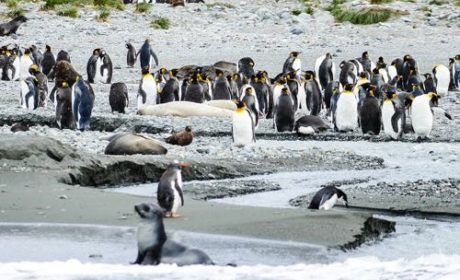Wildlife watching is one of my favorite active boomer travel adventures. Alan’s too. Of course we prefer to observe wildlife in their natural environment, like we did on a South African safari.
Seeing Pandas in China

When it comes to wildlife experiences, seeing pandas in China has long been on our bucket list. But that’s not possible in the wild, so a research or breeding facility is the best opportunity to see giant pandas, which we did on a Chengdu panda tour.
Why can’t you see pandas in the wild?

Solitary animals, pandas live in the remote bamboo forests in the mountains of south-central China. Although no longer listed on the endangered species list, pandas are still considered vulnerable to extinction due to habitat loss and fragmentation of that habitat. According to WWF (World Wide Fund for Nature), 1,864 giant pandas live in the wild, a 17% increase in the last decade.
But as good as that news is, Alan and I would have to hike long and hard through a wet, bamboo rainforest for the rare chance to see a panda in the wild. And that day may come sooner than we think. The Guardian writes that China is creating a giant panda reserve to boost the wild population of pandas.
Where to visit pandas in China?
Chengdu, the capital of Sichuan Provence, is panda central when it comes to panda tours. But there’s much more to see than giant pandas.
With a population of over 14 million people, Chengdu is the 7th largest city in the world. The metropolis has a history dating back to the 4th century B.C., which is the focus of the Jinsha Site Museum.
The Changing Faces show at the Sichuan Opera is another fascinating thing to do in Chengdu. However the Chengdu Research Base of Giant Breeding (Chengdu Panda Base) is the most popular activity when it comes to Chengdu tourist attractions.
Alan and I arrived in Chengdu after completing a Yangtze River Cruise on the Yangtze Explorer. When the cruise ended in Chongqing, our group took the 2-hour fast train to Chengdu. From accommodations at the Shangri La Hotel Chengdu, the drive to the Chengdu Panda Base took about 30 minutes.
Our Chengdu panda watching experience

Alan and I visited the Chengdu Panda Base on a hazy, hot, March day. Actually that haze is pollution. Following our guide’s advice, we rode the tram up the hill to the back gate and then visited the panda exhibits as we walked down the hill. Smart.
Standing in front of the giant panda enclosure, we watch as the pandas eat and eat some more. One roly poly panda holds a slender bamboo shoot in his paws as he reclines against a tree.
Pandas eat between 26 and 83 pounds of bamboo each day to find enough nutrition to sustain them. As you can imagine, eating is the major focus of a panda’s day—and extremely tiring from the number of lounging and sleeping pandas that Alan and I observed during our visit.
Although it feels somewhat like a zoo, the Chengdu Research Base of Giant Pandas Breeding is actually a breeding and conservation facility for giant and red pandas. At the time of our Chengdu panda tour, visitors could pay around $300 U.S. for a photo opportunity with a toddler panda.
Participants dressed in gowns, booties and gloves provided by the Chengdu Panda Base for a very short professional photo session with the baby panda. A stuffed panda, tie and other goodies were also included in the package. The money goes to support the center’s research.
Photos with pandas are no longer offered at the Chengdu Panda Base. Now panda lovers must drive an hour and a half to Dujiangyan Panda Base to enjoy the privilege as part of the panda keeper program.
More to see than pandas

I’ll be honest, a short visit to watch giant pandas munch on bamboo and lounge around in their enclosures is all the time you need. Taking photos is difficult because of other tourists crowding against the fence, not to mention air pollution greatly affects photo quality, which is why you don’t see many photos in this article. However you can entertain yourself for hours if toddler pandas happen to be frolicking in their playground.
Interacting with the groups of Chinese elementary students visiting the pandas is part of the fun, too. At least it was for Alan and me.
While sitting on a bench, we became the curiosity for a group of exuberant school kids who were fascinated by two baby boomers from the United States. A teacher approached to ask if the children could practice their English on us.
After nodding yes, a steady procession of smartly uniformed children peppered us with “Hello” and “How are you?” It was just as much fun as watching giant pandas.
Tips for taking a Chengdu panda tour:
- Arrive in the morning when the pandas are most active. Feeding time is between 8:30 and 10:00 a.m.
- To see panda newborns, plan your trip for August or September. Baby pandas live in Moonlight Delivery House and Sunshine Delivery House
- Avoid a summer visit. Pandas retreat to their indoor enclosures during the heat.
- Bring allergy medications if air pollution triggers respiratory problems.
- Three hours on a morning visit is plenty of time to see the pandas as they mostly eat and sleep.
- Be prepared for crowds. This is the most popular Chengdu tourist attraction.
Are you planning a boomer travel adventure? Start your research at our Boomer Travel Planner page.
Save to Pinterest
Did you know that we publish a weekly broadcast with the latest articles from My Itchy Travel Feet, timely trip inspiration and travel deals? Subscribe by clicking here.




